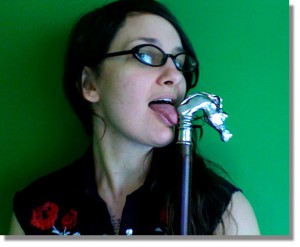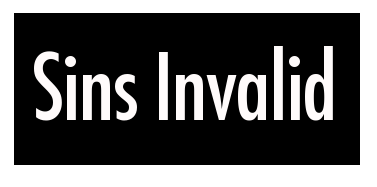An Intimate Interview with Sins Invalid Artist Ellery Russian
 by Stacey MilbernELLERY RUSSIAN is an artist, writer, makeup artist, comic artist, and physical therapist living in Seattle, WA. Ellery is the author of the zine "Ring of Fire", Co-Director of the documentary "Third Antenna: A Documentary About the Radical Nature of Drag", and has performed across the country and internationally doing drag and integrated dance and reading poetry. As a long-time admirer of Sins Invalid, Ellery is honored to perform in this year’s show and would like to dedicate hir performance to the memory of Vic Chesnutt.What do you identify as "the work" that you do? The work that Sins Invalid does?I think Sins is doing groundbreaking work in terms of performance and also with disability justice and liberation. To me Sins Invalid does 3 really important things -- curating the work of artists with disabilities (artists with disabilities often aren’t able to access most artistic communities to develop their work), building relationships, and doing work in leading the emerging disability justice movement.Why is Sins Invalid important to you, personally? I really appreciate that in Sins, the creative work is so centered in total embodiment of all aspects of self. You don't have to sacrifice any parts of yourself, you're totally embraced to bring it all, and that is so edgy that it totally adds to this component around the erotic.I've made some of the most meaningful relationships through Sins and I've been able to bring a lot of fuel back to my home in Seattle. The disability experience is so lonely and isolating sometimes -- even in activist communities. With Sins Invalid, it is different.Can you expand on the isolation piece?Sure. My mobility changes and a lot of people think of me as a walking person, but I'm not always a walking person. Last year I had my fourth surgery and I was using crutches. Most of my current friends didn’t really know how to support me. It was a very real reminder that people don't think about access issues, ever. For example -- so many community gatherings are at house parties, up a flight of stairs. Last year I went with my crutches and I totally fell on the stairs. It drove home the point: I forced myself to go to the event and then I fell because it wasn't accessible.You mentioned that Sins Invalid does a lot of work around "Disability Justice" -- what does disability justice mean to you?The way I understand the Disability Justice Movement as it’s developing is that it seems distinctly different from what people have historically understood as the Disability Rights Movement. The Disability Rights Movement has been more of a single-issue movement. And not that there hasn't been leadership by people of color in disability rights, but it's been predominately white. It’s focused on a lot of basic issues of access, which is so important, but has not moved beyond that access point. I'm excited about Disability Justice because it's looking at the bigger picture of where all these things come together.Can you explain more? What “things”?Yeah. Like I said earlier, I grew up in Seattle. When WTO protests happened in 1999, I was there in my wheelchair with all the bullets and pepper spray. It was really powerful because all of these labor unions, environmentalists, food rights people, and Zapatistas were there. The issue of globalization brought all these different movements together to unite. When people look at the disability experience, they think of it as a personal flaw that is an individual’s problem. No one sees the connections we could make as movements.When you think of the disproportionate amount of people with disabilities in prisons, who are homeless and who are living under the poverty level and without healthcare, you can see how all those issues are disability issues. Prisons are a disability issue. Housing is a disability issue. Healthcare is a disability issue. These are issues all connected to so many communities. If we could see that instead of just thinking "Did we get an ASL interpreter? Do we have a van?", we could look bigger and all work together. It helps you expand your mind about the possibilities of movement-building.What is one thing that you're excited about in this year's show?I'm really excited about one of the dance pieces that Aurora Levins Morales is doing. It's about the rehab she did after her stroke. She talks about rehabilitating her sexuality and it's this gorgeous dance piece. It just makes me cry it's so beautiful. I'm also really excited about a video collaboration I did with Patty that I got to illustrate. It's about a crip sex moment. It'll be showing in the lobby.Can’t wait to see it! Thanks for a great interview. See you April 8-10 at the show.See you there.
by Stacey MilbernELLERY RUSSIAN is an artist, writer, makeup artist, comic artist, and physical therapist living in Seattle, WA. Ellery is the author of the zine "Ring of Fire", Co-Director of the documentary "Third Antenna: A Documentary About the Radical Nature of Drag", and has performed across the country and internationally doing drag and integrated dance and reading poetry. As a long-time admirer of Sins Invalid, Ellery is honored to perform in this year’s show and would like to dedicate hir performance to the memory of Vic Chesnutt.What do you identify as "the work" that you do? The work that Sins Invalid does?I think Sins is doing groundbreaking work in terms of performance and also with disability justice and liberation. To me Sins Invalid does 3 really important things -- curating the work of artists with disabilities (artists with disabilities often aren’t able to access most artistic communities to develop their work), building relationships, and doing work in leading the emerging disability justice movement.Why is Sins Invalid important to you, personally? I really appreciate that in Sins, the creative work is so centered in total embodiment of all aspects of self. You don't have to sacrifice any parts of yourself, you're totally embraced to bring it all, and that is so edgy that it totally adds to this component around the erotic.I've made some of the most meaningful relationships through Sins and I've been able to bring a lot of fuel back to my home in Seattle. The disability experience is so lonely and isolating sometimes -- even in activist communities. With Sins Invalid, it is different.Can you expand on the isolation piece?Sure. My mobility changes and a lot of people think of me as a walking person, but I'm not always a walking person. Last year I had my fourth surgery and I was using crutches. Most of my current friends didn’t really know how to support me. It was a very real reminder that people don't think about access issues, ever. For example -- so many community gatherings are at house parties, up a flight of stairs. Last year I went with my crutches and I totally fell on the stairs. It drove home the point: I forced myself to go to the event and then I fell because it wasn't accessible.You mentioned that Sins Invalid does a lot of work around "Disability Justice" -- what does disability justice mean to you?The way I understand the Disability Justice Movement as it’s developing is that it seems distinctly different from what people have historically understood as the Disability Rights Movement. The Disability Rights Movement has been more of a single-issue movement. And not that there hasn't been leadership by people of color in disability rights, but it's been predominately white. It’s focused on a lot of basic issues of access, which is so important, but has not moved beyond that access point. I'm excited about Disability Justice because it's looking at the bigger picture of where all these things come together.Can you explain more? What “things”?Yeah. Like I said earlier, I grew up in Seattle. When WTO protests happened in 1999, I was there in my wheelchair with all the bullets and pepper spray. It was really powerful because all of these labor unions, environmentalists, food rights people, and Zapatistas were there. The issue of globalization brought all these different movements together to unite. When people look at the disability experience, they think of it as a personal flaw that is an individual’s problem. No one sees the connections we could make as movements.When you think of the disproportionate amount of people with disabilities in prisons, who are homeless and who are living under the poverty level and without healthcare, you can see how all those issues are disability issues. Prisons are a disability issue. Housing is a disability issue. Healthcare is a disability issue. These are issues all connected to so many communities. If we could see that instead of just thinking "Did we get an ASL interpreter? Do we have a van?", we could look bigger and all work together. It helps you expand your mind about the possibilities of movement-building.What is one thing that you're excited about in this year's show?I'm really excited about one of the dance pieces that Aurora Levins Morales is doing. It's about the rehab she did after her stroke. She talks about rehabilitating her sexuality and it's this gorgeous dance piece. It just makes me cry it's so beautiful. I'm also really excited about a video collaboration I did with Patty that I got to illustrate. It's about a crip sex moment. It'll be showing in the lobby.Can’t wait to see it! Thanks for a great interview. See you April 8-10 at the show.See you there.
